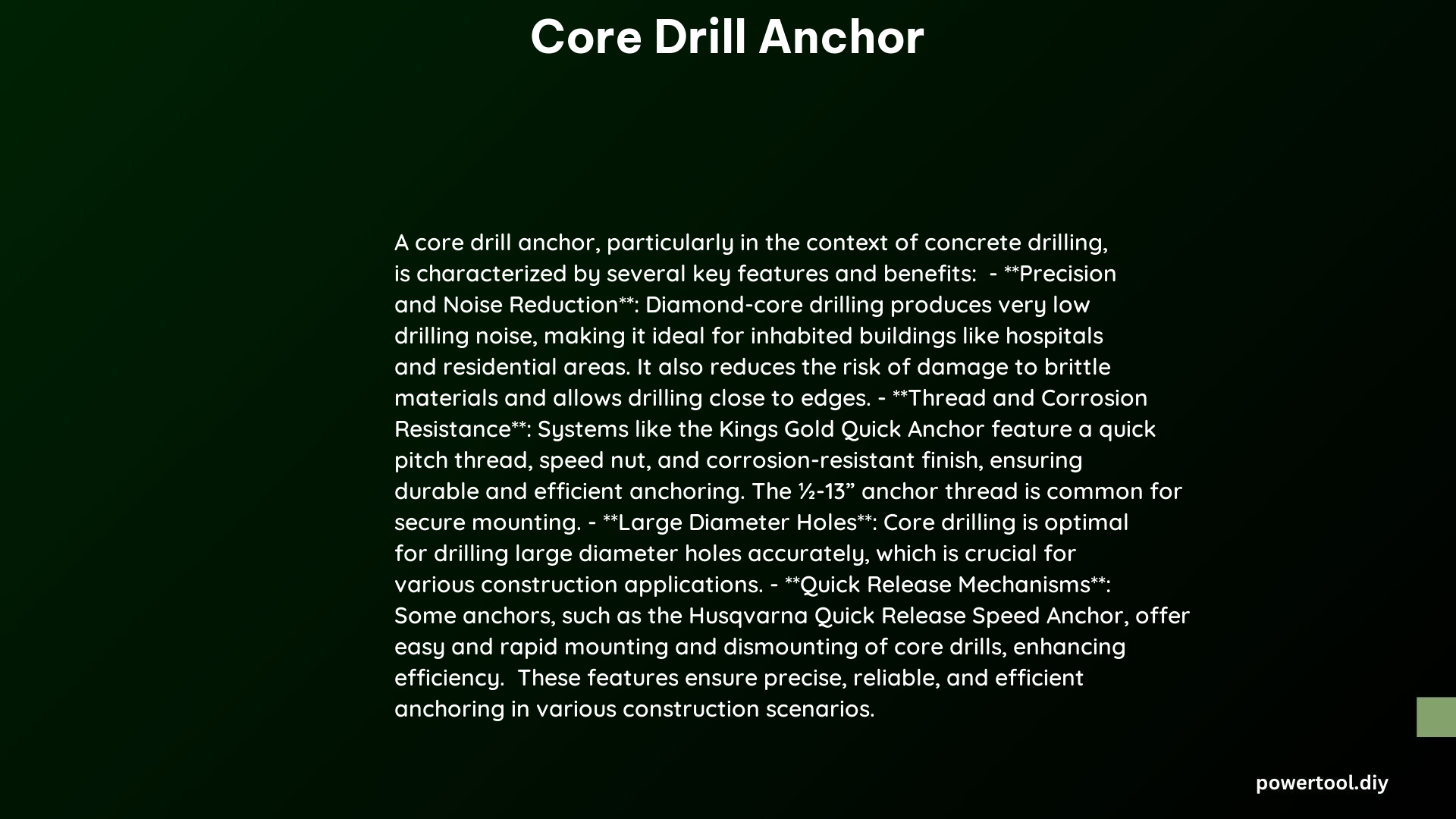Core drill anchors are crucial components in construction and drilling operations, providing stability and safety for core drilling equipment. These anchors secure the drill rig to various surfaces, ensuring precise and controlled drilling. Proper installation of core drill anchors is vital for maintaining equipment stability, operator safety, and achieving accurate drilling results. This comprehensive guide explores the types, installation procedures, and key considerations for core drill anchors.
What are Core Drill Anchors?
Core drill anchors are specialized fastening devices designed to securely attach core drilling equipment to various surfaces, primarily concrete or masonry. They play a critical role in stabilizing the drill rig, preventing movement during operation, and ensuring accurate and safe drilling processes.
What Types of Core Drill Anchors are Available?

Core drill anchors come in several types, each suited for specific applications and surfaces:
- Mechanical Anchors
- Expansion Anchors
- Adhesive Anchors
Let’s compare these types in detail:
| Anchor Type | Material Composition | Applications | Performance Metrics |
|---|---|---|---|
| Mechanical Anchors | Steel or alloy | Concrete, brickwork | High pull-out resistance, shear strength |
| Expansion Anchors | Steel or alloy | Concrete, brick, block | High pull-out resistance, dependent on substrate |
| Adhesive Anchors | Chemical adhesive | Hollow or weak substrates | High shear and tensile strength, sensitive to environment |
How to Install Core Drill Anchors?
Proper installation of core drill anchors is crucial for ensuring the stability and safety of your drilling operation. Follow these steps for a secure installation:
- Choose the appropriate anchoring method
- Prepare the drilling surface
- Mark drilling points
- Drill anchor holes
- Insert anchors
- Secure the rig
- Tighten the anchors
- Test the rig stability
What are the Depth Requirements for Core Drill Anchors?
The depth of core drill anchors is a critical factor in their performance. Consider the following:
Minimum and Maximum Depth Requirements
- Mechanical Anchors: Typically 1/4″ deeper than nominal anchor embedment
- Expansion Anchors: Usually 2-4 inches, depending on size and type
Calculations for Embedment Depth
- Based on load conditions and substrate compressive strength
- Deeper anchors generally provide higher pull-out resistance
- Maximum depth limited by drilling practicality and substrate integrity
What is the Load Capacity of Core Drill Anchors?
Understanding the load capacity of core drill anchors is essential for safe and effective operation:
Load Capacity Ratings
- Mechanical Anchors: Dependent on concrete strength and embedment depth
- Expansion Anchors: Varies based on substrate and embedment
Factors Affecting Load Performance
- Concrete compressive strength
- Environmental conditions
- Substrate quality
How to Ensure Safety When Using Core Drill Anchors?
Safety is paramount when working with core drill anchors. Follow these guidelines:
- Adhere to manufacturer’s instructions and safety guidelines
- Install anchors correctly and test for stability before drilling
- Wear appropriate protective gear
- Avoid using impact wrenches or core drills for anchor installation
What are the Best Practices for Core Drill Anchor Maintenance?
To ensure longevity and optimal performance of core drill anchors:
- Regularly inspect anchors for signs of wear or damage
- Clean anchors and surrounding areas after each use
- Store anchors in a dry, clean environment when not in use
- Replace anchors that show signs of corrosion or structural weakness
How to Choose the Right Core Drill Anchor for Your Project?
Selecting the appropriate core drill anchor is crucial for project success:
- Consider the substrate material (concrete, brick, etc.)
- Evaluate the load requirements of your drilling operation
- Assess environmental factors (temperature, humidity, chemical exposure)
- Consult with manufacturers or experts for specific recommendations
What are Common Troubleshooting Issues with Core Drill Anchors?
Even with proper installation, issues may arise. Here are some common problems and solutions:
- Anchor loosening during operation
- Solution: Retighten anchors, check for proper installation depth
- Anchor pull-out
- Solution: Use larger anchors or increase embedment depth
- Concrete spalling around anchor
- Solution: Ensure proper edge distance and spacing between anchors
How Do Environmental Factors Affect Core Drill Anchor Performance?
Environmental conditions can significantly impact anchor performance:
- Temperature extremes can affect adhesive anchors’ curing and strength
- High humidity may lead to corrosion in metal anchors
- Chemical exposure can degrade anchor materials over time
Consider these factors when selecting and installing core drill anchors for your specific project environment.
References:
